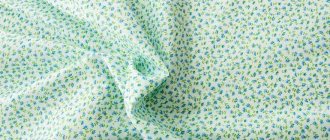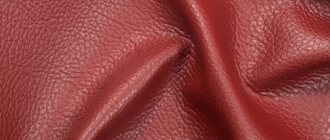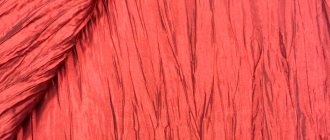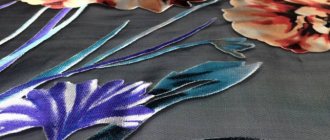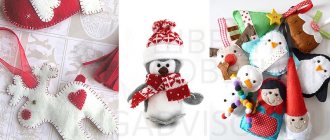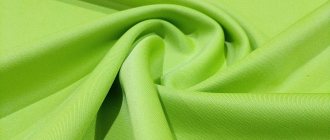Organza fabric is a transparent material that combines fine structure and rigidity. Like many other fabrics, it came to the European continent from the East and quickly became popular. Initially, it was made by hand from natural silk fibers, the process was complex and labor-intensive. Therefore, it was available to few and was used mainly for finishing clothes.
With the advent of synthetic fibers and new technologies, the production of the material has become less expensive, and it has become widely used in the clothing industry and other fields. Let's take a closer look at what kind of organza fabric this is and what its advantage is. This will help many people learn about the advantages of the fabric and its uses.
Composition and characteristics of organza
Industrial production of matter is based on the use of various raw materials:
- natural silk threads, which give the fabric a beautiful glossy shine;
- viscose fibers - soft, perfectly absorbing moisture;
- polymer fiber - a durable synthetic material.
Thanks to the use of the finest threads and a special weaving method, the result is an almost weightless, transparent fabric. Synthetic fibers are pre-treated to create edges on their surface that give the surface a sparkling shine.
Despite its attractive appearance, organza material is highly durable. The combination of the advantages of natural silk and artificial threads provided high characteristics of the mixed fabric, including the following:
- resistance to deformation, does not form folds or creases when compressed;
- high strength, wear resistance;
- transparency, excellent ability to transmit light;
- resistance to organic solvents;
- after washing, the material does not deform and does not shrink;
- Ideal for creating curvy silhouettes.
Features include a not very pleasant, slightly scratchy surface, poor breathability, capriciousness when creating seams and high maintenance requirements.
Types of organza
Depending on the production method and the raw materials used, the material comes in two types - with a matte and shiny surface. It can be monochromatic and contain drawings applied in one of the following ways:
- machine embroidery;
- chemical etching;
- printing using equipment.
The most popular types of matter are:
- chameleon - changes color depending on the lighting;
- rainbow – characterized by a smooth transition of various shades;
- with spraying - a beautiful shimmering surface of golden or silver color;
- crash - resembles the appearance of broken glass;
- jacquard - with an ornament made by special twisting of threads;
- pressed - obtained by twisting and pressing, has numerous folds and creases.
To give it an original look, lurex decorations are used, and various ornaments are created using laser perforation.
Given the variety of options, many are interested in what kind of organza devore is this? This unusual variety is obtained by chemical processing, resulting in a beautiful pattern with a three-dimensional appearance on the surface. Drawings on canvases made from different fibers look most impressive. This material is used for interior design and finishing of various outfits.
When asked what linen organza is, you can answer that this fabric was created specifically for summer; it combines the advantages of natural linen and the practicality of synthetics. Clothes made from it are very soft, pleasant and provide a comfortable microclimate in the heat.
Properties of organza
The properties of the fabric depend on the chemical composition of the fibers. These properties could be:
1.
High strength.
2.
Crease resistance.
3.
High light transmittance.
4.
High tensile strength.
5.
Resistance to organic solvents.
6.
Maintaining original size and shape.
7.
Organza is a durable and practical fabric.
The rigidity of organza is caused by the strong twisting of the fibers. However, it should be noted that luxury fabric is difficult to cut. Before cutting, the organza needs to be smoothed, and this must be done with a dry iron; the steam will make the fabric wavy.
During cutting, the material slides, so you need to cut it on a fabric backing, first securing it with pins. You need to transfer the pattern using copy stitches. Carbon paper or a toothed wheel are not suitable for organza.
When cutting, it is necessary, as always, to make allowances, but in the case of organza they should be one and a half to two times larger than usual. The crumbling sections are processed with an overlock or zigzag, and can be stitched twice. While stitching, place paper under the fabric to prevent slipping.
When ironing seams, you must do this carefully, first removing the pins and placing fabric or tissue paper between the iron and the product. You should also not press with the iron. Ironing organza curtains is not an easy task; in this case, they should not be over-dried. But the best option for curtains would be organza-reaper or organza with appliqués.
Types of organza
1.
Chameleon organza is a fabric that changes color depending on the angle of incidence of light, which is due to the interweaving of threads of different colors in the warp and weft.
2.
Organza-rainbow - in this fabric there is a transition from one color to another. Multi-colored vertical stripes in this fabric smoothly change each other.
3.
Plated Organza – Fabric with gold or silver plating is gorgeous.
4.
Organza with aluminum threads – the shiny fabric is incredibly beautiful.
5.
Crash organza – with a “crash” effect, fabric with a crinkled effect.
6.
Organza can be smooth or crinkled, plain or colored. Patterns are applied by printing or etching. The perforation with laser cutting is especially beautiful.
7.
Organza decorated with embroidery is the most expensive.
There is no limit to the imagination of chemists, technologists and designers. There is also airy jacquard organza made from fibers of different thicknesses, compositions and colors.
Where is the material used?
| The durable and transparent material is widely used in a wide variety of fields. Perhaps this is one of the most festive fabrics. Delicate holiday dresses, evening dresses are sewn from it, and used for decorative finishing of clothes. It is often used to create dance and masquerade costumes. A separate direction is the production of various accessories and decorative items. Premises for special events are often decorated with miniature trees, bouquets, and bows made of colored fabric. Lovers of “hand made” crafts and professional designers simply adore it; they create real masterpieces - original lampshades, canopies, decorations and covers for furniture. Gift packaging made from this material looks sophisticated and elegant. In interiors, products made from transparent fabric allow many design ideas to be realized; they are used for zoning rooms, adjusting space, and decorating windows. With this design, the interior looks stylish and airy. Thanks to the variety of textures and color palettes, you can choose the most suitable curtain option for your existing style. |
The use of organza in creativity
The properties of the material allow it to be used in many areas of creativity related to floristry, needlework, and crafts.
An indispensable material for floristry
Floral organza is used to decorate flower arrangements. It is chosen to form the packaging of simple bouquets, assembled in a “spiral”, or curly. To do this, cut into several squares and form around the composition, with the corners up.
The elasticity of the fabric is convenient for “vertical” bouquets. It is used to decorate bouquets, creating a contrast with the main shades. The material is also suitable for gift wrapping of potted plants. It is cut into squares, placed in the middle, the fabric is collected and tied with a ribbon.
Decor of sweet bouquets
I often use organza to create compositions from corrugated paper. In particular, in bouquets of candies to fill the spaces between the main elements. Cut equal squares or circles and fold several times. Then they are attached to skewers or toothpicks with tape and secured into a bouquet.
For candy arrangements, transparent fabric is often needed to decorate the packaging. Bouquets of soft toys are also wrapped in organza packaging. It is more suitable for such crafts than corrugated paper.
Using floral organza, they create original packaging for boxes of chocolates, tins of cookies or tea. Additionally, the gift can be decorated with flowers and other decorative elements.
Sailboats and ships made of corrugated paper cannot do without organza for floristry; it is used to create sails.
Handicraft uses
Topiaries of various themes are made from organza. Used as decoration for flower, sisal or fruit trees. They create the necessary volume and fill voids in the work.
To make flowers for topiary, a piece is cut into small squares and folded diagonally twice, and attached to the workpiece. The elasticity of the material allows you to give it the desired shape.
Organza jewelry can withstand additional work elements: beads or rhinestones. Hot glue or Moment Crystal are suitable for this work; they are not capable of damaging the integrity of the canvas.
Airy material is often used to design photo shoots or events. For themed birthdays for girls, he is used to sew dresses and tutu skirts.
For a wedding, you can use it to sew bonbonnieres for guests or use it as a decorative element of accessories, for example, pillows for rings.
The material is suitable for creating decorative flowers, New Year's crafts, as well as elements of postcards in the works of schoolchildren. Ideal for sewing bags for gift wrapping. The use of floral organza is unlimited! Even the trimmings come into use!
Organza care
To care for delicate items, it is recommended to follow a few rules:
- When washing in an automatic machine, you should choose a delicate cycle and a temperature no higher than 40 degrees. If the item has embroidery or crystal decorations, it should be washed by hand. In all cases, it is necessary to use a gel, not a powder. Bleaching agents can damage the structure of the threads.
- After washing, the product is gently wrung out by hand and dried flat. Iron wet through a thin fabric, setting the iron to the minimum temperature.
- Before washing and other procedures, it is worth studying the recommendations that are usually present on the label or packaging.
White products can become dull over time and acquire a gray tint, so the pressing question is how to bleach organza at home. Experts recommend the following method. It is necessary to dissolve two tablespoons of table salt in cold water and soak the item in this solution for 8-10 hours. This will help restore not only the snow-white appearance, but also the splendor of the product. But, the ideal option would be to use dry cleaning services.

